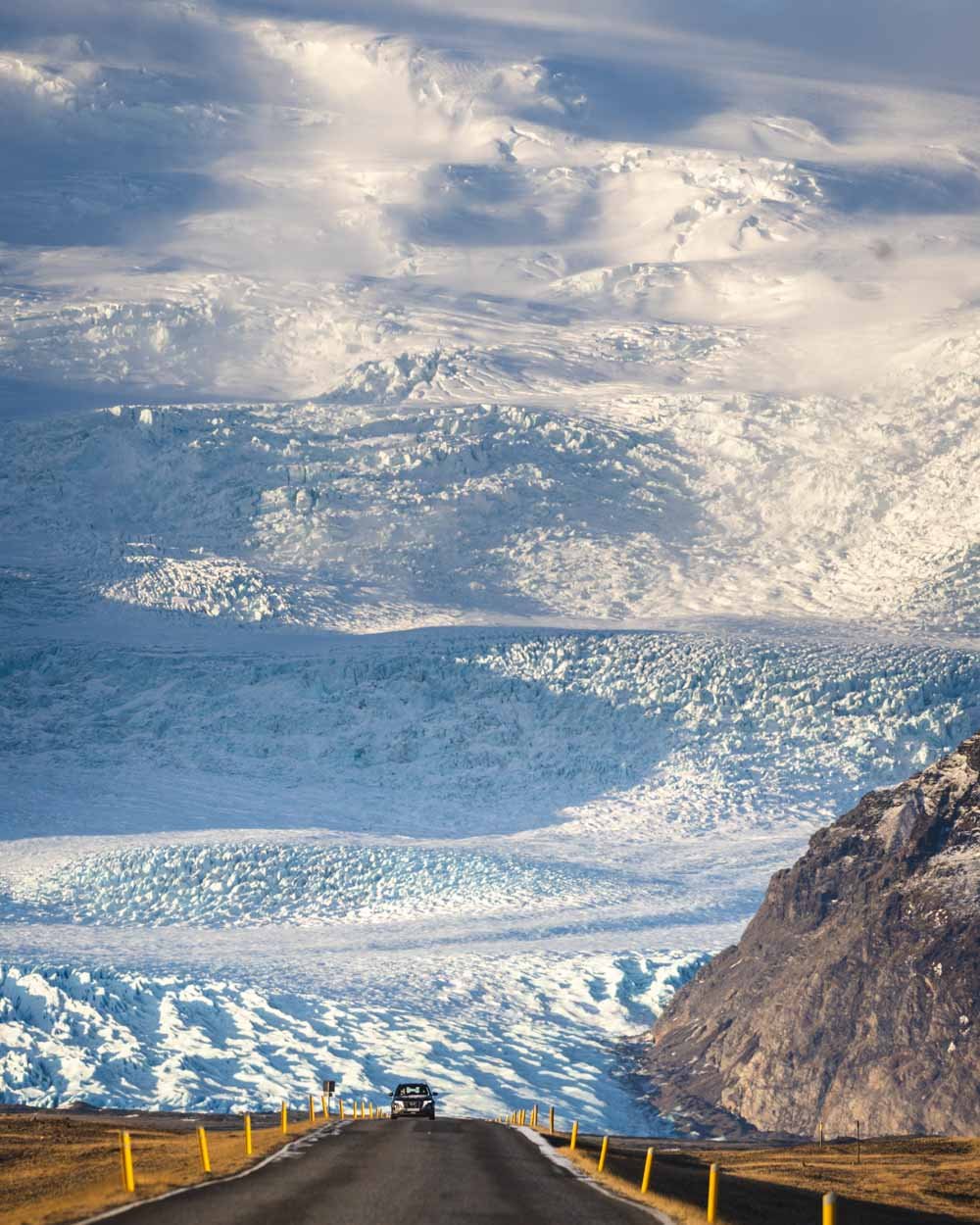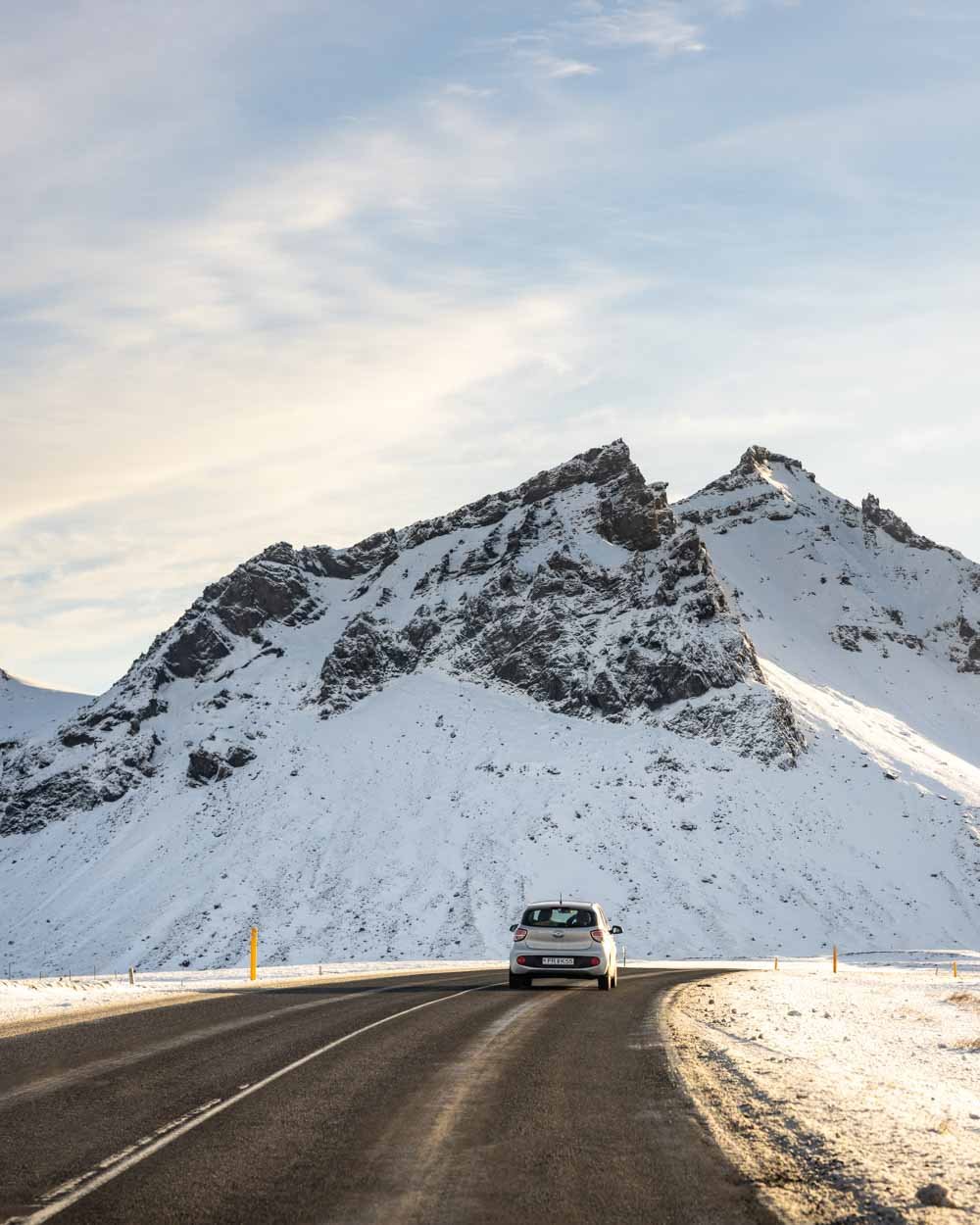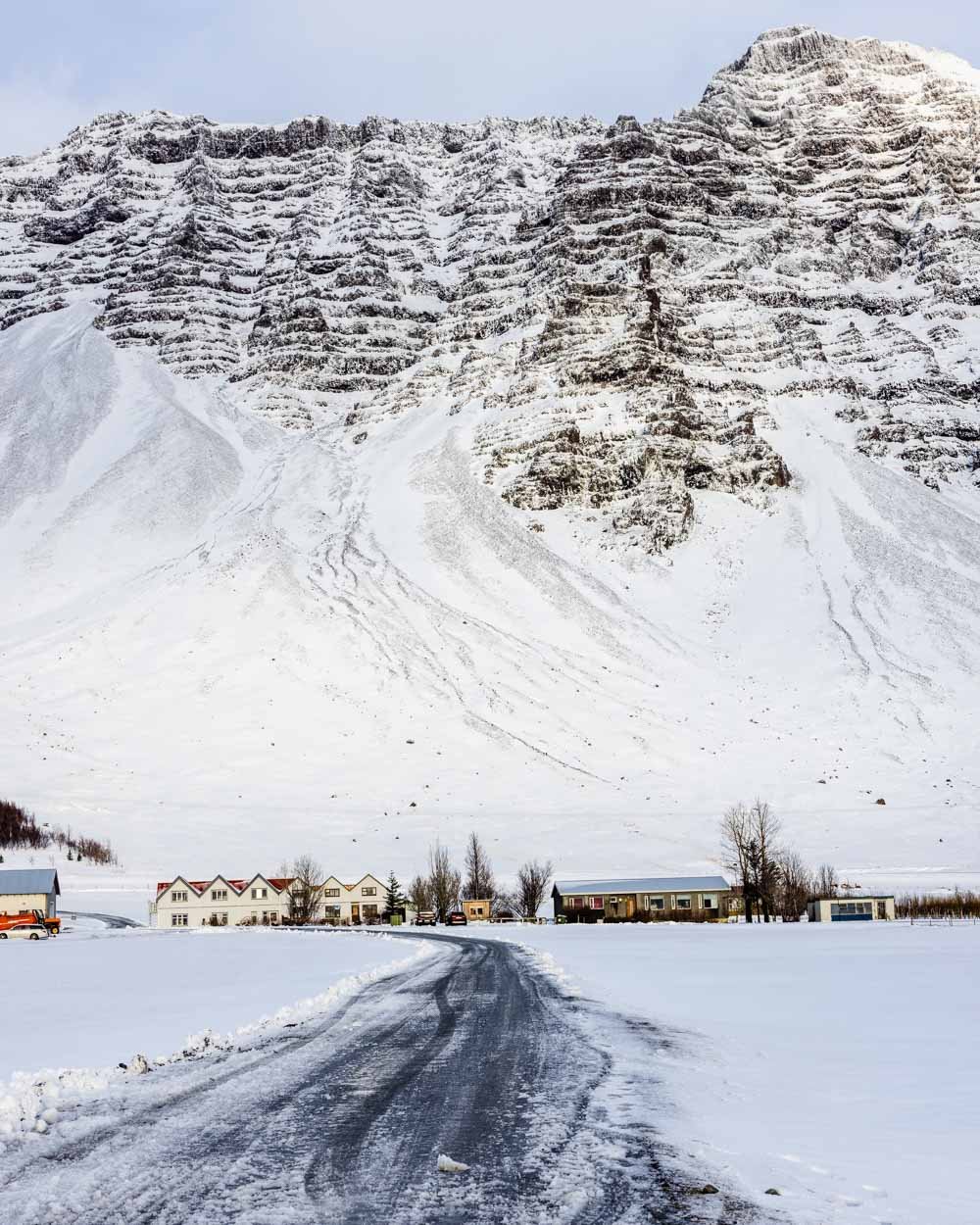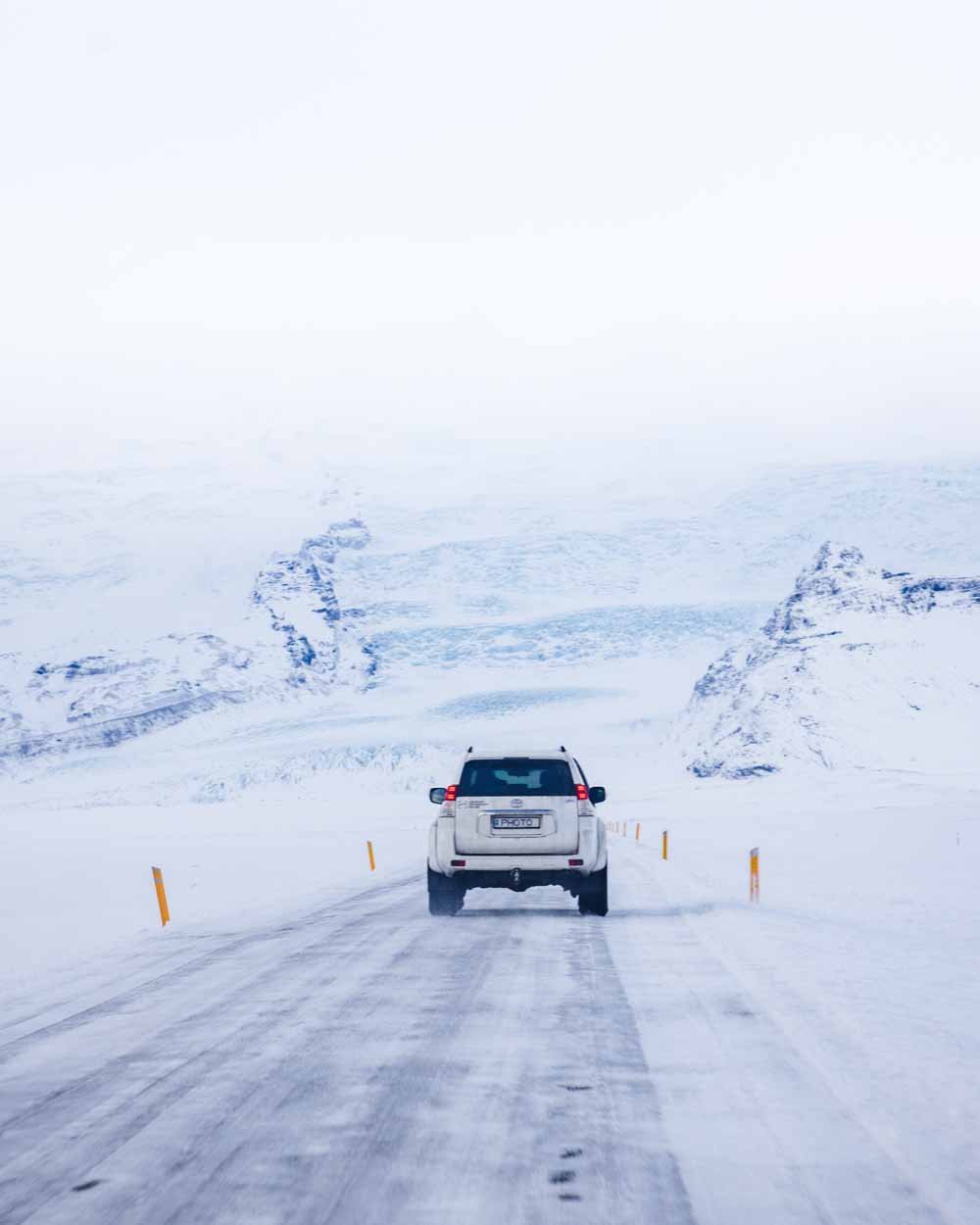If you’re like us and you prefer independent travel to tours, then you’re probably thinking about renting a car for your Iceland winter trip. However, you might be slightly worried about road conditions and whether it’s actually safe to do so.
We are far from experienced winter drivers, but we decided to bite the bullet because we aren’t tour people and didn’t want to be confined to the city. We spent 11 days road tripping Iceland and learnt a lot along the way. Overall, we’re so glad we rented a car and wouldn’t do it any other way, but there are a number of things to consider before you do.
In this guide we’re going to share everything we learnt about Iceland winter driving from the perspective of people who have next to no experience in these kinds of conditions.
A quick note on Iceland winter driving
Before we get started on the tips, it’s worth noting that you may encounter excellent driving conditions and have nothing to worry about throughout your trip. We did have some amazing days, when the roads were perfect and no different to driving in summer. If you’re only doing a short trip this could be all that you experience, but given the severity of stormy periods during Iceland’s winter, you have to be prepared to drive in difficult conditions.
You don’t need to be an experienced winter driving - we definitely aren’t - but you do have to be a relatively confident driver. We had some quite long stretches of icy driving, which weren’t much fun, and I was relieved when it was over. However, we didn’t have any moments when I felt like the car would skid off the road or anything like that, and that’s why it’s important to have a good car with studded tyres.
All the roads you’ll be using in winter are paved and snowplows patrol regularly. However, if it’s snowing hard, then the snow accumulates again before it’s re-plowed.
Tips for driving in winter in Iceland
1. Stick to the south coast
You might luck out with glorious weather and excellent driving conditions, but if you want to be on the safe side, then we’d recommend sticking to Reykjavík, the Golden Circle and the South Coast for a first winter trip.
We went as far as Jökulsárlón Glacier Lagoon, which is roughly a five hour drive from Reykjavík (in reasonable conditions). The reason we’re suggesting this area is that we were advised by a car hire company that these were the easiest roads to drive, so it made sense for our first winter trip here.
Despite picking this area of ‘easier driving’, we still encountered some hairy conditions, so we were glad we hadn’t tried to venture up north this time around.
2. Hire a 4WD if you’re leaving Reykjavík and the Golden Circle
Technically speaking, if you’re sticking to the south coast, you don’t need a 4WD. There was never any moment where we actually had to engage 4WD, yet we still recommend having one.
This is mainly due to the intense wind and frequent icy conditions we encountered. We felt much safer in a big car, which was buffeted less in the wind, and generally felt pretty sturdy. In the 11 days we drove around Iceland, we only saw a handful of smaller cars. Almost everyone drives, or rents a 4WD.
If you’re only going to drive around Reykjavík and the Golden Circle, and you have a few days to pick a decent weather window for the Golden Circle, then you can definitely rent a small car.
But otherwise it’s best to opt for a 4WD. Our car cost just under US $31 a day, so it’s surprisingly cheap to rent a 4WD in winter. Make sure your car has studded tyres - I can’t imagine any company not giving them to you in winter, but just in case! Studded tyres were all we needed for the trip and we never had to worry about snow chains.
3. Expect the unexpected
I know it’s a cliche to say that the weather in Iceland is unpredictable, but it’s definitely on another level to anything we’ve experienced before. You can have beautiful blue skies turn to foreboding storms that really limit your visibility very quickly. Sometimes these moments are five minutes apart.
Our arrival
A few hours later
Weather forecasts can be pretty good, but they can also get it very wrong - even our trusted Yr.no which we use all over the world and is generally accurate.
You can see in the photos below the weather we were predicted on the Golden Circle vs the weather we actually got. Even if you have a good forecast, you need to be prepared to drive in bad conditions too.
4. Check the road safety website, particularly before any lengthy journey
Iceland’s road safety website is excellent. It’s really easy to use and will allow you to see conditions along your whole route. Some days it can be really good weather where you are, but awful somewhere along your route.
That’s why it’s a good idea to check the full route to make sure you don’t pass through a dodgy area without realising, as the weather might look good at both your start and end destination.
The website will show all the major Icelandic roads and what the conditions are like along each stretch. This can range from easily passable, to slippery, slushy snow, or the dreaded very slippery.
You can also see wind speed and if there is snow blowing over the road, amongst other things. The website is updated regularly and the Twitter feed is just slightly ahead of it.
The website will generally let you know ahead of time if a road is going to close due to predicted adverse weather.
5. Prepare to be flexible
This is related to the above points about unpredictability, but you may have to be flexible.
We were in Jökulsárlón when we saw that the road to our next destination (Vik) would be closed for almost 24 hours (we were able to see this around 24 hours ahead of time on the road safety website).
Knowing ahead of time meant we could reschedule our ice cave tour and rearrange our accomodation.
All the hotels that we had booked happily moved our reservation by a day at no extra cost - Icelander’s are used to bad weather and they are really accommodating where possible.
Our hotel in Jökulsárlón gave us a late checkout - without us even asking - when the road opening was delayed by a further few hours.
It does mean you may end up missing a few things that you had on your list, but it’s better than attempting to drive in dangerous conditions and running into trouble.
We drove to Vik the day after the snow storm had passed through and we saw quite a few abandoned cars and cars that had slid off the road - it’s definitely not worth taking the risk!
6. Watch out for the wind
Even on a spectacular blue sky day the wind can be pretty ferocious. It’s another reason we were grateful for a 4WD, as a few times you could feel the car start to move sideways slightly, and I can only imagine it would be much worse in a small car!
When driving there’s not much you can do apart from lower your speed and keep a firm grip on the steering wheel.
When you get out of the car keep your hand on the door at all times and close it quickly.
Our car rental company told us the week before we arrived they’d had two cars which had their doors ripped off by the wind and apparently no insurance will cover this.
7. Allow more time than you think you’ll need
Timings on Google Maps are generally pretty accurate if the conditions are good, but if it’s icy it can take a lot longer.
We had several icy drives which took about an hour longer than expected and visibility was good, it was only the road that wasn’t. It’s best to allow more time than you think you’ll need, particularly if you’re trying to do all your driving in the daylight hours.
8. All F roads are closed
Many parts of Iceland are not accessible in winter, with all F roads being closed, as well as many roads in places like the Westfjords and the highlands.
This means that if it’s your first, or the only trip you’re palnning to make to Iceland, you’re going to have to manage your expectations. There are still many amazing things you can do in Iceland in the winter, but you are limited.
In that sense it’s a great first trip as all the big hitters like the Golden Circle and Vik are accessible and it’s also amazing to see the landscape covered in snow.
If it’s going to be your one and only trip and you have a great big list of things you want to see, then winter might not be your best option.
9. Buy a local sim or use a roaming package for your phone
We had surprisingly good phone signal in Iceland, even along remote stretches of the Ring Road. If you do run into difficulties when driving, having a working phone will mean you can call for assistance.
Although the south coast is incredibly popular, we sometimes went for almost an hour without seeing anyone on the road, so it’s best not to rely on passing traffic.
If you need roadside assistance there should be a number inside your hire car, if you need medical help, the number to call is 112.
10. Keep your camera ready
I wanted to end on a positive note because though there were some hairy times, we loved our winter road trip! The roads in Iceland are just spectacular, and though I haven’t been lucky enough to see them in summer yet, I can’t imagine it could be more beautiful than in winter.
The snow covered mountains are magical and we even encountered something completely unique to us, snow on the beach!
The day after the storm blew through we were driving with mountains on one side and the ocean on the other, but every bit of land inbetween was blanketed in a thick layer of snow.
I felt like I was driving through a documentary on the Arctic, it was incredibly special and one of the most memorable drives of my life!
How to find the right rental car in Iceland
Researching companies
If you’ve decided that you’re up for the challenge of driving in the Icelandic winter, you’ll want to get the right car. As we stated earlier, you’ll probably want to hire a 4WD and from a reputable company.
We use Rentalcars.com as not only does it compare several companies, it shows you all the relevant information you need to know on the search results: a review score of the company, the mileage (ideally you’ll want unlimited miles for Iceland), whether it has free cancellation and the transmission.
You can also click on the “Important info” button to find out about the insurance policies. We’ve snagged quite a few bargains with Rentalcars.com, so check out the prices for your winter road trip by clicking below.
A note on insurance
Before visiting Iceland, we’d read that some people had issues with the kind of insurance you need to take out before arriving.
The biggest problem is that some companies don’t include “Third Party Insurance” on the price of the rental, which is a legal requirement in Iceland. This means that you turn up to your rental car company and find that your real price is actually a lot higher.
The other problem is around the required “Collision Damage Waiver”. This is another insurance that you will want to be included, as without it you are fully liable for the entire cost of any damage.
The waiver always has a pretty high excess (ours was $2,300 USD), but you can buy an excess insurance policy that reduces it down to zero. We don’t recommend buying this from the rental car company, as although it will mean you have zero liability, you can often pay more for this insurance than hiring the car itself (we’ve seen it cost over $50 USD per day for this insurance!).
We recommend searching online for one before you go - as we travel a lot, we bought an annual policy that reduces the excess for any rental for up to 30 days for £120 ($145 USD), which is significantly cheaper.
This post may contain affiliate links, meaning at no additional cost to you, that we will earn a small commission if you click through and decide to make a purchase. This helps towards the costs of running our website. Thanks for your support.


























